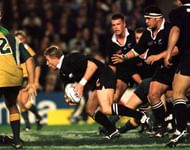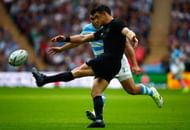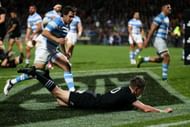The All Blacks are among the most feared at the Rugby World Cup. The name is associated with numerous iconic players, dangerous attacking schemes, vaunted counter-attacks and demoralising defences.
While New Zealand have seemingly taken a step back from their trademark dominance in recent years, they're still famous for their three-decade dynasty tracing back to the '90s. The nation's legacy atop the summit of world rugby is deeply engraved in the sport's history.
It's a legacy defined by names like Jonah Lomu, Dan Carter, Richie McCaw and Beauden Barrett. Not to forget coaching greats like Alex Wyllie, Graham Henry and Steve Hansen.
The All Blacks reigned supreme on the world stage and at the Rugby World Cup for about 30 years, with rival nations only really catching up in the last five years.
The 1990s: Age of the basic overlap

The initial stages of the Rugby World Cup saw a simple product of rugby being played by the globe's top competitors. While today's teams have adopted complex approaches to outwitting each other, teams back then just relied on speed and exploiting basic spaces in opposing defences.
The simplicity of the game meant that it didn't take must ingenuity to beat one's rivals. Defences were built on very basic structures, and attackers relied on them breaking down by simply passing the ball wide all the time - similar to today's style of Sevens play.
There wasn't an abundance of depth in how the game was played. Teams played with uncomplicated gameplans and a lot of spirit. So when coaches like Alex Wyllie applied minimal innovation, the All Blacks ran wild on opposing Rugby World Cup teams.
What Wyllie and many other Kiwi coaches learned was that by not committing all of the forwards to rucks and crash-balls, one can create constant overlaps out wide.
That was what largely defined the All Blacks' Rugby World Cup domination throughout the '90s. Moreover, with world-class names like Jonah Lomu and Andrew Mehrtens in attack, New Zealand was a true force to be reckoned with.
It was a ruck setup on one side of the field, with Jonah Lomu waiting on the end of an Andrew Mehrtens pass to the overlap on the other side.
The 2000s: A cross-kick from Dan Carter to Joe Rokocoko

While the All Blacks saw no Rugby World Cup glory in the 2000s, their dominance took on a more advanced form during this decade. Apart from their game of overlaps, they adopted more complex systems that allowed them to pull off spectacular counter-attacks and control the game more.
By delivering well-timed balls to a backline headed by the legendary Dan Carter, the Kiwis ran amuck on opponents out wide. Opposing centres and wingers were often left scrambling in defence as Conrad Smith, Mils Muliaina, Doug Howlett and Joe Rokocoko threw a disco of running rugby on them.
Of course, the All Blacks' vaunted product of running rugby out wide was often set up by turnovers from the likes of Richie McCaw. The iconic captain flanker earned himself a name for his ingenuity at ruck time.
His turnovers, combined with New Zealand's ability to produce quick balls at the ruck, laid the foundation for the thrilling All Black rugby we still reminisce today.
The 2010s: The All Blacks' great back-to-backs at the Rugby World Cup

The 2010s was a decade of redemption for New Zealand. While they fell short of hoisting the coveted Webb Ellis Cup the previous decade, they more than compensated in the final decade of their dynasty.
The historic years of 2011 and 2015 saw the men in black finally bag the back-to-back at the Rugby World Cup. It was an iconic unit that included the likes of Richie McCaw, Dan Carter, Ma'a Nonu and Julian Savea that had defined Kiwi greatness in the early part of the '10s.
More importantly, the decade saw the All Blacks develop the modern style of play that's commonly used worldwide to this day. While coach Graham Henry was the genius of the 2000s, it was mastermind Steve Hansen who revolutionised the 2010s.
By adopting tactical elements used at the club level, Hansen built a team that dominated at the Rugby World Cup as well as The Rugby Championship.
The country took the concept of blending forward players with backline players to the next level. In earlier years, forwards would simply stand in the backline to create an overlap. However, when rival nations caught up, the All Blacks had to innovate again.
To further the idea of blending forwards and backs, a new structure was introduced. Instead of forwards simply standing in the backline, they'd stand in their traditional flat position near the ruck. However, the flyhalf became the link to the backline, as he'd hang right behind these pods of forwards.
Traditionally, the scrumhalf would feed the pod for a simple crash ball. However, New Zealand (and Australia) added another dimension inspired by playing structures from the National Rugby League. The dimension basically involved the pod having the option to either run a crash ball or release out back to the flyhalf right behind.
The flyhalf would normally make the call for the forwards to either crash or release out behind. If there's nothing on out wide, the call would be to crash. If there's an opportunity out wide, the flyhalf calls for the ball, and the pod releases it out back to be run wide.
The system allows for seamless adjustments to be made on the fly. As the ball only sees the backs when the game calls for it, backlines can easily garner a reputation for being highly potent.
That's exactly what made All Blacks Beauden Barrett, Damian McKenzie, Rieko Ioane, Israel Dagg and Ben Smith some of the most feared names at the Rugby World Cup. When Barrett would send a wide pass out to a flying Rieko Ioane or Ben Smith ... it was on.
While it's easy to claim that the Kiwis have lost their grip on the summit of world rugby in recent years, one cannot deny their unprecedented impact on the beautiful game.
As the landscape of the Rugby World Cup changes, fans old and young will forever remember the thrilling experience of classical All Blacks running rugby.
